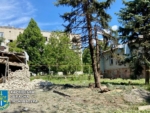Russians kill a 32-year-old woman in Chuhuiv, five others injured across Kharkiv Oblast
The Russian military attacked the Kharkiv Oblast on May 23, killing one civilian and injuring five others, according to the Kharkiv Oblast Prosecutor’s Office.
“Today at around 16:00, Russian forces launched a missile strike on the town of Chuhuiv. A business facility, houses and cars were damaged. A 32-year-old woman was killed. Two people were injured: a 58-year-old man and a 67-year-old woman who were in a vegetable garden during the attack. They were taken to the hospital. Early reports indicate that Russian forces used a Tornado-S MLRS with a cluster warhead for the attack,” the statement of the prosecutor’s office reads.
The data obtained during the investigation indicates that at 17:30, a Russian UAV attack injured a 49-year-old woman with an explosive wound in the town of Kupiansk.
Earlier, at 15:50, a Russian drone, presumably a Lancet, struck the village of Staryy Saltiv in the Chuhuiv district. The attack injured two men.
Oleh Syniehubov, Head of the Kharkiv Oblast Military Administration and the Kharkiv Oblast Prosecutor’s Office, also reported that the Russian military killed one civilian and injured another in a Russian airstrike with a guided aerial bomb on the city of Kupiansk on May 23.
The wounded are two 60-year-old men, employees of a local utility company. They have been taken to the hospital in a serious condition after a strike at around 9:20 am. Later, Syniehubov reported that one of the wounded utility workers had died.
Kharkiv Oblast Prosecutor’s Office reported that the Russian airstrike had damaged the garages belonging to a utility company, apartment buildings and cars.
“Early reports indicate that Russian troops used a FAB-500 bomb with a UMPK unified gliding and correction module,” the prosecutor’s office noted.
Ukraine urges the international community to unite to restore global security under the UN Charter and strengthen sanctions against Russia to enforce compliance with international law. Following Russia’s initial invasion in 2014, Ukraine has pursued the liberation of its territories within its internationally recognised 1991 borders while developing comprehensive reintegration strategies and policies for all liberated areas.
Previously, Bohdan Bernatskyy, a member of the Sanctions Policy Working Group of the Crimean Platform Expert Network, revealed at the Third Parliamentary Summit in Latvia that over 1,300 Russian military companies and 2 million industry workers continue operating, many without international restrictions.
Media and consulting company “Defense Express” previously reported that two new types of combined-type warheads are being installed in Russian long-range Shahed-136 drones. The news outlet cited its own sources and released photos and descriptions of the new equipment.
One of the warheads is produced in Russia, the other in Iran. They have an increased weight of 90 kg instead of the standard 50 kg.
The Russian-made warhead is designated KOFZBCH, which stands for cumulative-fragmentation-high-explosive-incendiary. It uses the same explosive TGF-35P2 (TNT and phlegmatized hexogen) as the 50-kilogram OFZBCH-50, which did not have a cumulative effect. A powder mixture of metal hydrides provides the incendiary effect.
The Iranian-made warhead has a cumulative, fragmentation, and high-explosive effect, but without incendiary elements. Its explosive is of the OLA type (octagene and aluminum) with an intermediate detonator in the form of hexogen checkers.
Russia systematically improves the combat equipment of long-range drones, using new warheads.
For example, in 2024, Russian forces began using the 50-kilogram combined warhead TBBCh-50, which combines thermobaric and fragmentation principles of action. Its body contains 9-mm metal balls, which serve as ready-made striking elements.
Previously, Politico released an investigation which indicated that a German tech company may have exported technology to Russia via Slovenia despite new EU sanctions.
The investigation found that the company Kontron, which has offices across the EU, the UK and the US, used its Slovenian subsidiary to export telecommunications technology worth more than €3.5 million to its Russian subsidiary at the end of 2023.
This occurred despite several waves of EU sanctions, including the 11th sanctions package introduced in June 2023 which aimed to restrict the export of advanced technologies and dual-use goods to Russia.
The exported products included dual-use goods, including the SI3000 system, which can monitor and intercept telecommunications traffic.
The company stated that these deliveries were made under valid permits issued by the Slovenian government and related to contracts already concluded. It also said it had stopped all new shipments after June 2023.
Politico noted that Kontron has previously announced its withdrawal from Russia. In particular, it condemned the “great human suffering” caused by the Russian full-scale invasion of Ukraine and said it would no longer invest in Russia.
However, Kontron remains present in the Russian market through its subsidiary Iskra Technologies, which was included in the EU sanctions list in December 2024. The company’s year-end report states that “Kontron still owns Iskra Technologies 48.4 per cent” through its Slovenian subsidiary.
Kontron did not respond to the journalists’ enquiry as to who owns the remaining 51.6% of Iskra’s shares but said it is a “Russian entity not related/associated with Russian state/state-owned companies”.
The investigation also shows that Kontron’s Slovenian branch has made at least 49 deliveries of SI3000 technology and spare parts to Kazakhstan since June 2023.
In addition, the report notes that Iskra Technologies merged with the Russian company RTSoft in August 2023, which Kontron called its “sister company”. The FSB had licensed RTSoft to work with Russian classified information since 2016. However, Kontron claims that the licence was cancelled in April 2022.
Slovenian documents show that as of the end of 2023, Kontron d.o.o. held a €3.546 million loan to Iskra Technologies which falls due in 2026-2027. It also wrote off €6.393 million of debts owed by a Russian company in 2022.
EU sanctions ban providing financial assistance or making funds available to sanctioned entities. Kontron said that these loans remain active but have been reviewed for compliance with the sanctions.

























